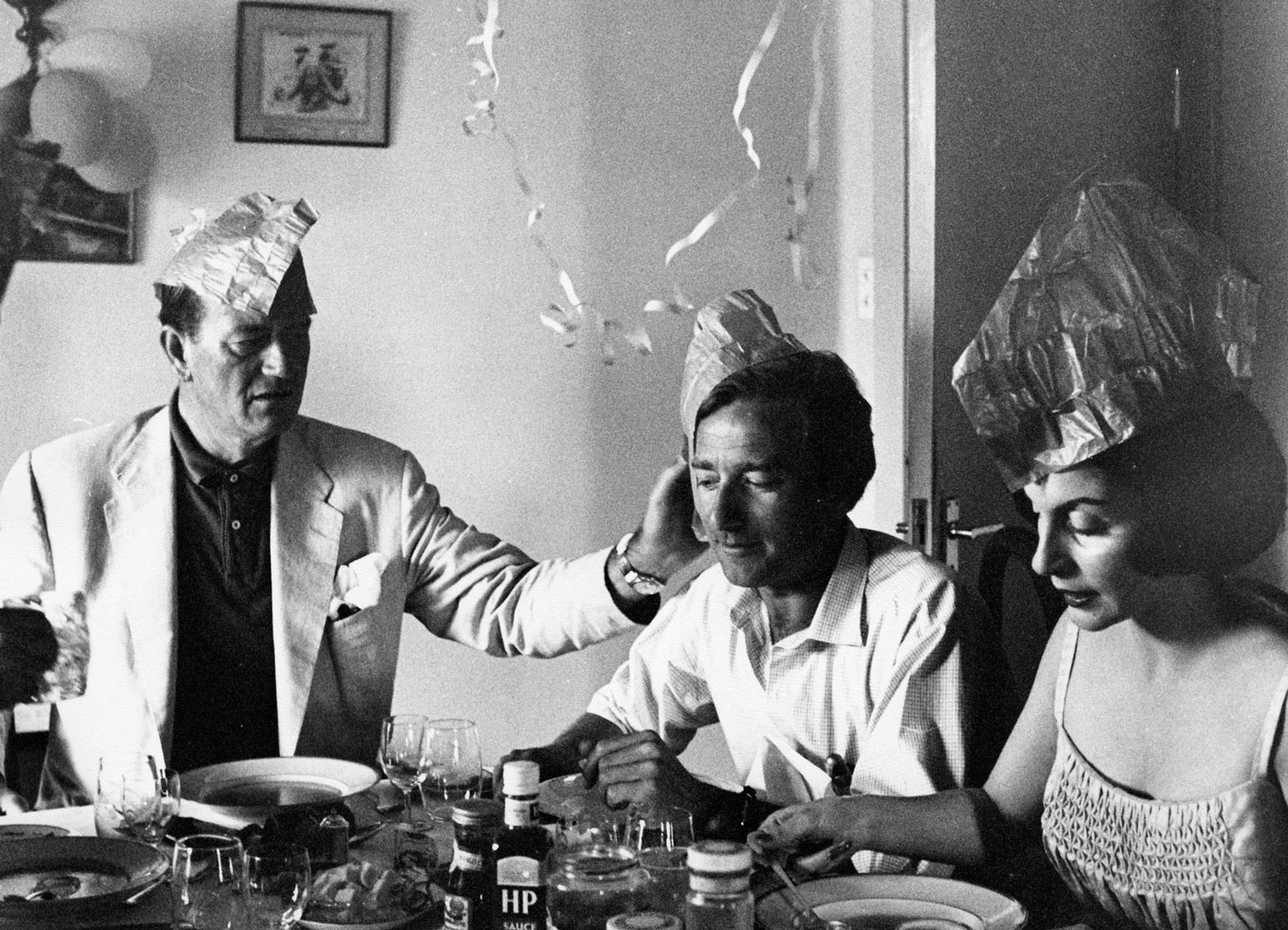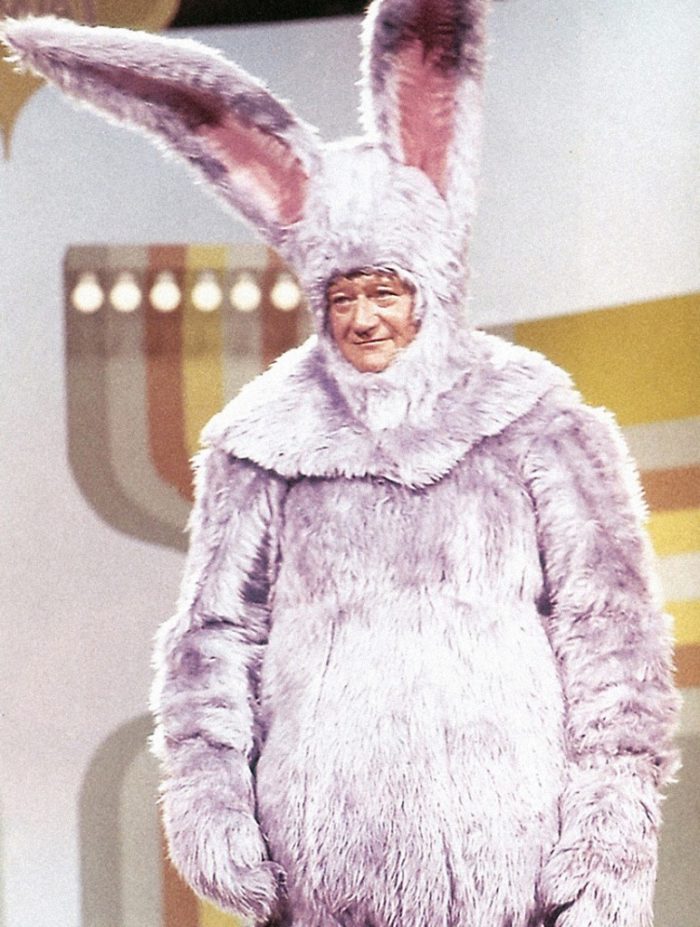John Wayne and Pilar Wayne enjoying a celebratory dinner with friends in Africa. Photo courtesy of John Wayne Enterprises
Written by Michael Goldman
John Wayne’s legacy includes dozens of classic film roles all Duke fans know well, but there is one role he played that seldom gets much attention. It was a brief, television cameo actually, on September 11, 1971. That’s the day the most macho actor alive appeared on the famed sketch comedy show, Rowan & Martin’s Laugh-In, dressed in a lavender bunny suit, lamenting that the outfit made him “feel like a liberal.”
Such parodying of his own image was something Duke happily cooperated in. It was, in fact, one of 15 times that John Wayne appeared on what was, back then, considered a hip, counter-culture, youth-oriented show between 1968 and 1973.
Since this month would have been Duke’s 110th birthday, we thought it appropriate to pause and remember him as close family and friends do—a fun-loving, practical-joking guy whose “sense of humor is vast,” according to a profile of him written by journalist Wayne Warga while Duke was promoting Rooster Cogburn. It’s also instructive to examine his use of humor over the years, often strategically. Indeed, John Wayne, despite his image, gruff exterior, and passionate beliefs, was never above poking fun at himself and others he was close to, both on camera and off. On camera, for instance, Laugh-In was just one of dozens of comedic television shows he guest-starred on between the 1950’s and the 1970’s.
John Wayne on famed sketch comedy show, Rowan & Martin’s Laugh-In in 1971. Photo courtesy of NBC
In fact, the greatest cinematic tough guy of all time goofed around on sitcoms like The Beverly Hillbillies (1967), I Love Lucy (1955), The Lucy Show (1966), and Maude (1974), and a huge range of comedic variety shows with the likes of Bob Hope (six TV specials), Dean Martin (four Dean Martin TV roasts and one variety show appearance), Don Rickles (one), Jack Benny (one, plus a tribute program to the great comedian), Jimmy Durante (one), Milton Berle (one), Red Skelton (twice), and Jonathan Winters (once), not to mention appearing on People are Funny with Art Linkletter (1957), The Super Comedy Bowl (1971), and six times with Johnny Carson on The Tonight Show between 1971-76.
Comedy actually came easy to Duke, because off-camera, humor was among his most obvious traits. The letters he sent to his mentor and friend, director John Ford, ooze with natural one-liners, teasing, and cracks at the expense of their mutual buddy, actor Ward Bond. He especially liked to tease Ford with cards on his birthday, such as the 1953 card he sent for Ford’s 42nd birthday in which Duke revised the words of the traditional “Happy Birthday” song:
“We’re flat on our ass, our room rent is due, but never mind us, happy birthday to you.”
At Duke’s annual Thanksgiving cattle auction at his 26 Bar Ranch, he typically did a bit of stand-up before getting on with auctioning off his prize bulls, and drafts of many of those scripts exist in his Archives today. In November of 1973, for instance, he told the assembled throng that “Bulls go to the highest bidders, which makes it a lot like politics. The only trouble is that in politics, they have a lot more bull to sell than we’ll ever have.”
His Archives also include the speech he gave in December of 1974 to the National Football Foundation and College Hall of Fame. Some of the material he used that night included, once again, making fun of himself and his acting career.
“I’ve been in more uniforms than Georgie Jessel, I’ve been in more battles than Napoleon, and more wars than Germany,” he declared. “I’ve captured Bataan, Corregidor, Fort Apache, and Maureen O’Hara. But I stopped getting the girl about 10 years ago, which is just as well, because I’d have forgotten what I wanted her for.”
But it wasn’t just the telling of jokes that Duke enjoyed—he liked doing practical jokes whenever he could. Those who worked with him on movies over the years say his practical jokes on set were commonplace. Stuntman Terry Leonard remembers being a rookie on the film The Train Robbers (1973) with Duke when he injured his knee during what he calls “a late Saturday night excursion” the night before having to shoot a physically taxing scene. He claims that John Wayne heard about his “incident” and sent the assistant director to pull him out of his trailer early the next morning, telling Leonard that “Mr. Wayne needed to see me right away.”
“I’m thinking, I’m going to get fired,” Leonard recalled a few years ago. “I was petrified, because I didn’t know him that well yet and was supposed to be conducting myself in a dignified manner. So, I go to see him and he says, ‘I hear you had a little trouble Saturday night.’ I said, ‘yes sir, I was trying to defend myself.’ He looked at me, smiled, and said, ‘sounds to me like you are the real John Wayne.’ ”
And Duke wasn’t above playing such stunts on his own family either. According to his youngest daughter, Marisa Wayne, in a story she related in an issue of the Official Collector’s Edition John Wayne magazine last year, Duke once went out of his way to pull a fast one on her sister, Aissa, and Aissa’s friends. Marisa said that when Aissa brought some friends with her to a house the family was renting in London during the filming of Brannigan, the young girls were worried the old house was haunted.
“He put my sister and her friends on the top level,” Marissa recalled. “In the middle of the night, he would go up there and move stuff around and tilt paintings on the wall to make it look like there was a ghost doing all this. She came tearing down the stairs to [tell everyone], and he’d just roll his eyes, saying she was imagining things. Then, he’d give me a quick wink.”
However, John Wayne’s oldest surviving daughter, Melinda, points out it was a lot harder to successfully play a practical joke on her father than to fall prey to one. During the making of McClintock, she recalled showing up on set in Arizona to surprise her father. She had a wardrobe person dress her in a Native American costume, with her face covered, to stand in line with other extras and get an autograph from her father.
“I handed him a piece of paper, he signed it and then said, ‘Hi Melinda, when did you get here?’” she says. “I asked how he knew it was me, and he said it was because of my smile.”
Duke seemed to instinctively understand that humor can bring people together regardless of beliefs or circumstances, and he was certainly in favor of bringing people together. When the satirical publication Harvard Lampoon invited him to do “battle” over political ideologies in Boston in January of 1974, while he was in town to promote McQ, Duke not only accepted, he used the occasion to win over his younger, liberal audience using his characteristic good humor.
He staged a publicity stunt on the day of the event by riding through Cambridge’s Harvard Square in an Army Reserve armored personnel carrier, and then engaged in friendly back-and-forth ribbing with his “foes” for a couple hours. When asked, at one point, if he looked at himself as the embodiment of the American Dream, he wielded humor as a sword and told his questioner, “I don’t look at myself more than I have to.”
Later, he wrote the Lampooners a friendly thank-you note and told family members that the event, coming at a time when his health was in decline, made him feel better than he had been in months. Melinda chalked that result up entirely to humor.
“Those students wanted to murder him politically, and instead, he made them laugh,” Melinda points out.
One can only imagine what kind of one-liner Duke would have cracked today at the thought of suddenly being 110 years old, but there is little doubt he would have had a good one ready.
Michael Goldman wrote the 2013 award-winning book that examined letters and documents from John Wayne’s personal archive—John Wayne: The Genuine Article. Goldman has authored six books about major media-related topics, legends, and institutions, including co-authoring a textbook on filmmaking, an acclaimed coffee-table book on director Clint Eastwood’s filmmaking techniques called Clint Eastwood: Master Filmmaker at Work, an authoritative history of the USC School of Cinematic Arts, and more. He has also written for acclaimed film journals like American Cinematographer, CineMontage, DGA Quarterly, Emmy magazine, Millimeter, Post magazine, Variety, and consumer publications like the LA Times, Orange County Register, Philadelphia Inquirer and others. Goldman also podcasts interviews with filmmakers monthly at the Studio Daily site in a series called Podcasts from the Front Lines. You can learn more about his work at his Website—www.hollywood-scribe.com.




